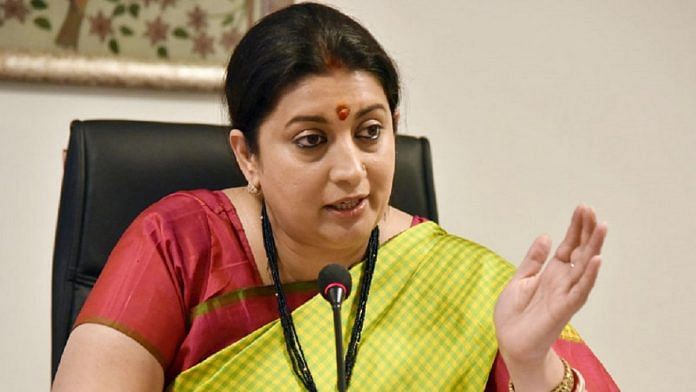New Delhi: Decisions taken by Smriti Irani in her capacity as the human resource development minister between 2014 and July 2016 continue to haunt the ministry, with three vice-chancellors appointed by her having to resign due to various allegations within the last couple of years.
Allahabad University V-C Rattan Lal Hangloo was the latest — his resignation was accepted by the President of India on 3 January. Ministry sources said that a three-member committee has been set up to look into the allegations against Hangloo.
The resignation of Hangloo, who was appointed by Irani in 2015, comes in the wake of allegations of corruption and mishandling of sexual harassment cases. He has said he was “being hounded” and that the allegations against him were “baseless”.
In 2018, Arvind Agarwal, the V-C of the Mahatma Gandhi Central University in Motihari, Bihar, resigned over allegations that his PhD was fake. Agarwal had been appointed by the Irani-led ministry in February 2016.
In 2017, Jawahar Lal Kaul, V-C of Garhwal University, was asked to resign following allegations of corruption against him. He had been appointed by Irani in 2014.
Even while she was at the HRD ministry, Irani was surrounded by controversies, especially about appointments. Eminent nuclear scientist Anil Kakodkar, for instance, resigned as IIT-Bombay chairman in 2015, after a tiff with Irani. However, Irani’s successor Prakash Javadekar reinstated Kakodkar, while in July 2017, then-President Pranab Mukherjee cleared a proposal to appoint him chairman of IIT–Roorkee.
But even now, when Javadekar has been succeeded by Ramesh Pokhriyal ‘Nishank’ in Narendra Modi’s second term as prime minister, the HRD ministry continues to reel under the impact of Irani’s decisions. Here are a few examples.
Also read: Smriti Irani – controversial in Modi’s first term, ‘disinterested & aloof’ in second
New Education Policy
Work on a New Education Policy for the country had started during Irani’s time. She began by appointing a committee under former cabinet secretary T.S.R. Subramanian. However, Javadekar junked the committee’s draft policy and set up a new panel under the chairmanship of former ISRO chief K. Kasturirangan in 2017.
An HRD ministry official who spoke on the condition of anonymity said: “There were differences between some members of the Subramanian panel and Smriti Irani, which is why the recommendations were not received very well. For almost a year, nothing was done about them, and then, a new committee under Kasturirangan was formed.”
The Modi government is now going ahead with the New Education Policy based on the Kasturirangan panel’s recommendations, which were submitted in May, the day Pokhriyal became the HRD minister. Sources in the ministry say the policy is at its final stage, waiting for the approval from the Cabinet.
Also read: India’s draft education policy isn’t a conservative conspiracy. But it may never take off
Contentions over IIM Autonomy Bill
The Indian Institute of Management (IIM) Autonomy Bill also underwent several changes after Irani left office. Irani wanted the government to have a bigger role in the institutes even after they become autonomous. However, this was not acceptable to the Prime Minister’s Office, and after a lot of back and forth, the draft was finally changed when Javadekar took over as the HRD minister.
The main point of contention was making the President a Visitor to the IIMs, which the ministry under Irani advocated, but the PMO staunchly opposed. It was proposed that the Visitor would have a role in the appointment of IIM directors, reviewing the functioning of an institute and the dismissal of its director and chairperson. The clause was ultimately removed under Javadekar.
Now, IIMs are completely autonomous from the government, and can appoint their own directors and board members.
Regulations for Institutes of Eminence
The plan to create ‘Institutes of Eminence’ (previously called ‘World Class Institutions’) had been mooted during Irani’s tenure, and the ministry had started working on the guidelines.
Ministry sources said, in this case too, Irani and the PMO disagreed on certain rules being drafted.
It was around this time that Irani was sent to the textile ministry in a cabinet reshuffle.
“There were many things going on between Irani and the PMO, which we assume have led to her being shunted, but she was eventually removed during the period when discussions on the IoE regulations were underway,” a source said.
One of the contentious regulations was regarding Letter of Intent (LoI), which is given to an institution when it is selected as an IoE. Irani wanted the LoI to not be transferrable from one sponsoring organisation — such as Reliance, in the case of the proposed Jio University — to another sponsoring organisation in case the institution was unable to fulfil the necessary criteria.
A ministry source who worked on the draft regulations said: “Making the LoI transferrable would have given rise to a lot of corruption.”
The PMO eventually went with Irani’s proposal to make the LoI non-transferrable.
“The LOI issued to the Sponsoring Organisation is non-transferable. The composition of Sponsoring Organisation cannot be changed,” the final regulations read.
Also read: Smriti Irani’s Amethi act and the rise of palatable feminism in India







It appears strange that Modi didn’t counsel her on the broad parameters within which to make policies for her ministry. Such to and fro between her and the PMO is unnecessary and shows something is amiss in the working of the government. If she had her own views at variance with Modi, she should have been eased out long before she became a nuisance there. Modi invested lot of his trust and political capital in her but she finally let him down on performance of the ministry. Even in IB ministry, she did badly. Instead she could have been defence production or home as junior minister with specific tasks. Meenakshi Lekhi would been a better choice instead of Smriti. This is not to say that Smriti is bad but she didn’t rise up to the expectations due to her arrogant nature.